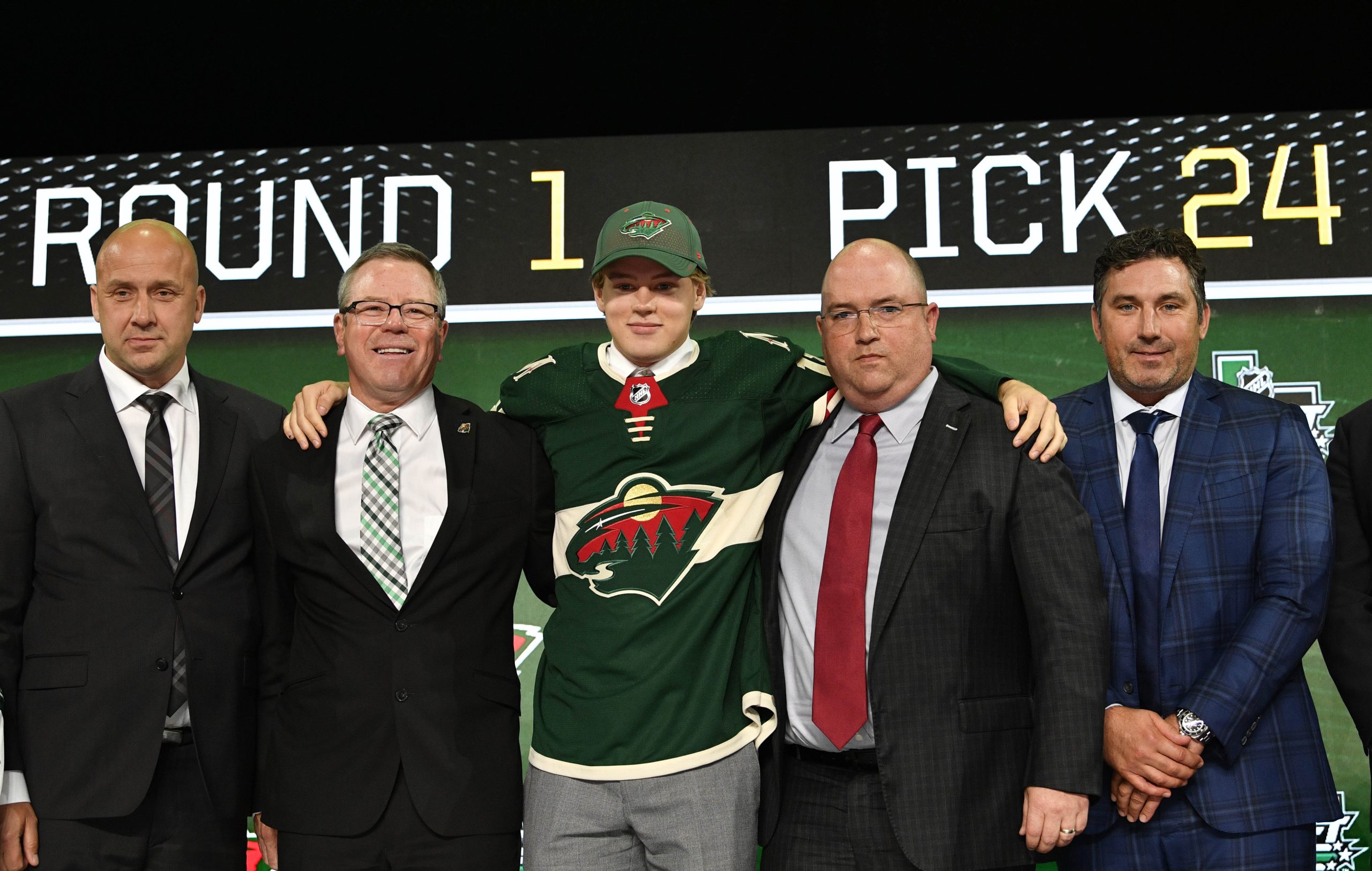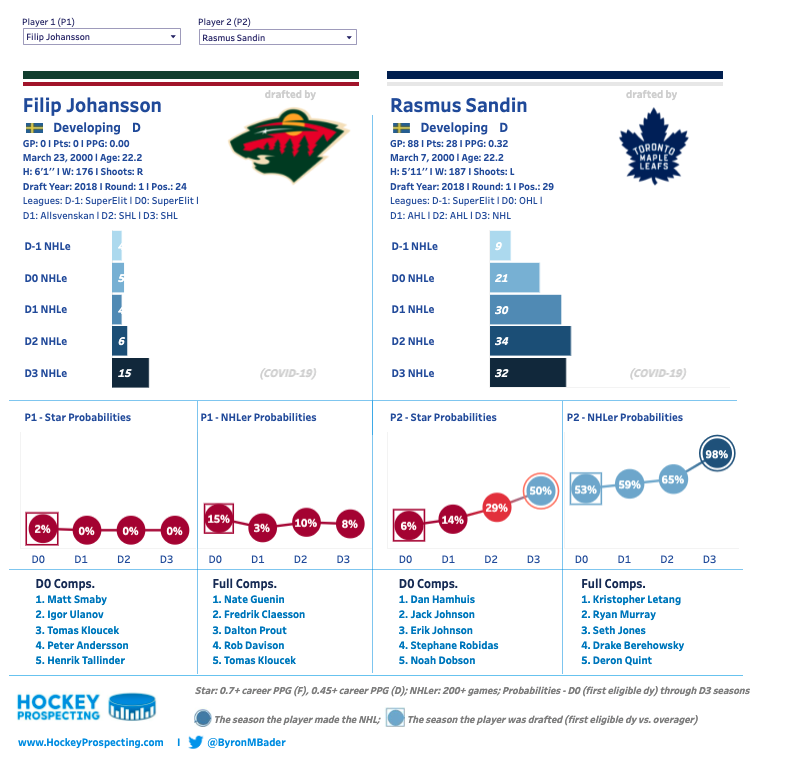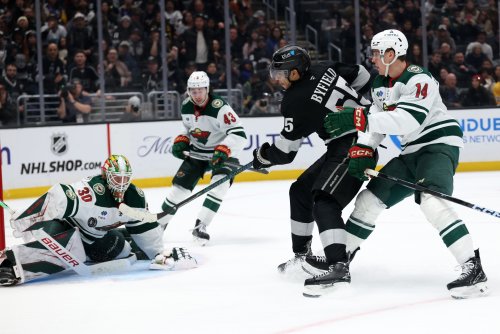
In retrospect, maligned former Minnesota Wild general manager Paul Fenton could pound his chest over many of his moves. Controversial moves to land Kevin Fiala, Mats Zuccarello, and Matt Boldy look great now. But there's one decision that turned out to be as baffling now as the night it happened. That would be drafting defenseman Filip Johansson 24th overall in the 2018 Draft.
To say Johansson was under the radar in 2018 is an understatement. He was a "late-riser," or a player who climbed up the draft rankings in the final stretch of the year. But Johansson could only make up so much ground, going from near obscurity to a consensus second- to third-round pick.
That's why fans were left scratching their heads as the Wild passed on more well-known prospects for Johansson.
Furthermore, Johansson was, statistically, one of the worst first-round picks of the 2010s. With just nine points in 29 Under-20 Swedish Junior games and eight in 34 games the year prior, nothing suggested he could produce at an NHL level.
Hockey Prospecting estimated that Johansson had just a 2% chance of becoming a star (scoring 0.45-plus points per game in his career) and a 15% chance of being an NHL player (200-plus games). Only Tanner Pearson (30th overall in 2012) had a worse chance of stardom among any first-round pick in the decade. No one had a worse chance of being an NHLer.
So perhaps it's not surprising that GM Bill Guerin's staff did not sign Johansson ahead of Tuesday's deadline. They'll receive the 57th overall pick in the 2020 Draft for giving up his rights. If the Wild didn't believe in Johansson, and it seems like they don't, then salvaging the 2018 pick with a late second-rounder is an okay scenario.
But wow, what a waste of a first-round draft pick.
Fortunately, Minnesota has beefed up its prospect pool despite this setback. But for a team that needs young, cheap talent, it stings that the Wild will have a second-round pick who'll still be three years away from contributing instead of a player in their lineup from that pick.
Who, though? Which player should they have picked instead? Let's take a quick look at the best players selected between 24 and 63 -- Minnesota used pick 63 on Jack McBain, who they turned into another second-round pick this season -- and figure out who Minnesota would take with a do-over.
If there's any silver lining for the Wild, it's that not too many people from the 2018 Draft are making a big impact for their teams yet. Only 27 have played 50-plus NHL games, and just 20 of those players have positive value in terms of Standings Points Above Replacement. And a lot of those players, like Andrei Svechnikov, Quinn Hughes, and Brady Tkachuk, were selected well before 24th-overall.
But teams have gotten some value from players between the 25th- and 62nd-overall picks. Leading the way with 2.7 career SPAR is Alexander Romanov. Romanov's points haven't developed like the Montreal Canadiens hoped when they took him at 38th overall, but he plays 20 minutes a night for the Habs. His defensive chops are advanced, and he can drive some offense, even if he only had 13 points to show for it last year.
Right behind him is Rasmus Sandin, with 2.6 career SPAR. The Sandin pick is an excellent example of why teams shouldn't draft for need. The Wild picked Johansson partially because of their system's lack of right-shot defensemen. But if they looked to Johansson's left at the U-18 World Junior Championships, they'd see his teammate Sandin, who the Toronto Maple Leafs picked at 29th.
Sandin was a better prospect at the time and has only raised his stock since then. Hockey Prospecting predicts a 50% chance at stardom, and scoring 28 points in 88 games in limited minutes backs that up. Worse yet, the Wild have a hole on their left side that they've spent money on Alex Goligoski, Dmitry Kulikov, and more to fix. Instead, they could just have Sandin on a team-friendly ELC.
[caption id=attachment_126260" align="alignnone" width="787] Courtesy of Hockey Prospecting[/caption]
Courtesy of Hockey Prospecting[/caption]
Left defensemen continue to be the name of the game when looking at the value the Wild left on the table in 2018. Scott Perunovich (45th overall), who played in Duluth, saw his first NHL action with the St. Louis Blues this season. He even helped eliminate the Wild with three playoff points, all in wins.
Jett Woo (37th overall, Vancouver Canucks) is a Judd Brackett pick who struggled in the AHL these past two seasons, perhaps partially due to COVID-19's impact. Still, Hockey Prospecting pinpoints his development curve as being similar to offensive defensemen like Alex Pietrangelo, Jakob Chychrun, and his No.1 comparable, Adam Fox. Even if that overstates his potential, that's more than Minnesota has right now.
If the Wild had to have a right-shot defender, they still messed up pretty badly. Nils Lundkvist (28th overall, New York Rangers) is yet another Swedish defenseman the Wild no doubt saw while scouting Johansson. Like Johansson, his stats in his draft year weren't exciting, but Lundkvist's development took off. Lundkvist has 25 NHL games already and a development trajectory similar to Matt Niskanen, a long-time Top-4 defenseman.
Or, get this, how about Calen Addison, who the Pittsburgh Penguins drafted 53rd overall? At that draft, Addison had the second-highest probability of being a star of anyone picked between 25th and 62nd (35%). Since then, he's raised his stock to the point where he has a 63% chance of stardom, still the highest of any defenseman in that range. If the Wild wanted a right-shot defenseman, that was a good bet to take, then and today.
Obviously, the Wild have Addison now, so you might call that a moot point. But Minnesota had to spend a valuable trade chip in Jason Zucker to acquire him. Had they simply drafted Addison, they could've picked up another prospect who could be NHL-ready today.
It's slim pickings at forward, but Kirill Marchenko (49th overall, Columbus Blue Jackets) is the clear best hindsight pick among them. And maybe not even just in hindsight. Hockey Prospecting pegged him at a 20% chance for stardom in his draft year, tied for 16th in the entire 2018 Draft Class.
Now the 6'3" winger has 114 career KHL games, where he averages 0.56 points per game, all before his 22nd birthday. The last person to do that? Another Kirill you may know. Of players to play 100-plus KHL games before age-22, he's behind only Kirill Kaprizov, Evgeny Kuznetsov, and Vladimir Tarasenko. That includes beating out Pavel Buchnevich (0.55 points per game) and Artemi Panarin (0.51). Hockey Prospecting rates his chances of stardom at 65%. That's the highest of any player in the 25-62 range in the 2018 Draft.
Oh, and he signed his ELC in May. Imagine the Wild having a 2 Dolla Bill Kirill next year.
Now, that's not to say Filip Johansson's career is over. He progressed in Sweden, and if not for the compensatory second-round pick, Minnesota may have signed him. But if he does carve out an NHL career, it won't be in Minnesota.
Whatever happens with Johansson's career, that 24th overall pick will stand as a gigantic missed opportunity. The Wild need every ounce of young, cheap talent they can get their hands on to compete over the next few years. If they can't quite manage to get enough, that exact moment in June 2018 will stand out as a glaring reason why.
Think you could write a story like this? Hockey Wilderness wants you to develop your voice, find an audience, and we'll pay you to do it. Just fill out this form.




.thumb.jpg.3818a5c4985e878d5ecaf2e7234883d8.jpg)


Recommended Comments
There are no comments to display.
Join the conversation
You can post now and register later. If you have an account, sign in now to post with your account.
Note: Your post will require moderator approval before it will be visible.